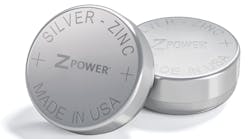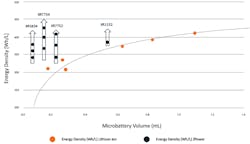In the 1990s, the commercialization of lithium-ion (Li-ion) batteries ushered in a new era of innovation. This revolutionary power source enabled the design of new products ranging from mobile consumer electronics to electric cars to sophisticated military and medical applications. Today, Li-ion batteries still play a fundamental role in hundreds of products that touch our lives every day.
Ironically, many of the products that were made possible by this revolutionary power source are now presenting demands that expose the limitations of Li-ion. Consumers today expect the next generation of devices, wearables, and other products to be smaller, safer, and longer-lasting. Li-ion batteries pose several challenges for design engineers tasked with developing this next wave of miniaturized consumer electronics.
For these smaller applications, silver-zinc is proving to be an extremely attractive alternative to Li-ion and other battery chemistries. This is especially true for manufacturers and design engineers who are concerned with four key areas:
- Energy density and run time
- Safety
- Regulatory and shipping complexity
- Device life and right to repair
In these crucial areas, silver-zinc provides the attributes necessary for designing safer, longer-lasting, and more robust miniaturized products.
Energy Density: Packing More Energy in Less Space
While Li-ion will continue to be the power source of choice for many products, manufacturers facing demands for smaller devices will find a welcome alternative in silver-zinc. Because of its construction, silver-zinc offers higher energy density in small size cells—an attribute that Li-ion is unable to claim.
Silver-zinc has similar energy density to Li-ion in battery sizes above 250 mm3. The real advantage of silver-zinc becomes apparent in devices requiring smaller batteries. As available space shrinks, Li-ion energy density falls sharply because of its wound “jelly-roll” construction, the Mandrel Cavity, and the lower current density of its electrodes (Fig. 1).
1. Due to the planar construction of silver-zinc batteries, the energy density remains proportionate as size decreases. The presence of the Mandrel Cavity in Li-ion batteries means that as the battery size is reduced, the active material constitutes a proportionately smaller area of the battery. As a result, energy density decreases substantially.
As size decreases, silver-zinc batteries provide higher energy density values and longer run time than any other battery within the same volume range (<250 mm3) (Fig. 2). For example, ZPower has developed microbatteries that offer a density of about 340 watthours per liter (Wh/L) at a size of 156 mm3. With planned increases in electrode utilization, these microbatteries will have energy densities of 370 Wh/L by the end of 2019, and 400 Wh/L in 2021.2. As microbattery volume decreases, silver-zinc maintains high density, while the energy density of Li-ion falls rapidly.
Safety: Solving a Hot Industry Issue
In recent years, safety incidents surrounding Li-ion batteries have attracted both media and legal attention—cellphones that overheat, laptops that begin to melt. These stories are more than anecdotal. Exploding Li-ion batteries in e-cigarette devices have sent more than 2,000 people to the emergency room in the past two years. And, according to the FAA, in 2018, fires from Li-ion batteries resulted in the grounding of one U.S. commercial flight approximately every 10 days.
While Li-ion battery failures are unlikely, with the proliferation of Li-ion powered devices in the marketplace, even a small failure rate can have substantial repercussions. In 2006, an incident with a 1-in-200,000 breakdown triggered the recall of nearly six million devices when microscopic metal particles came into contact with other parts of the battery cell, leading to a short circuit. Recalls of this scope not only impact manufacturer profitability, but can also lead to consumer concerns about the quality and safety of a brand’s products.
Silver-zinc batteries use an aqueous chemistry that poses no risk of fire or overheating. This is particularly relevant in applications such as wearables, hearables, medical devices, on-body military devices, and other technologies that come in close contact with the user.
The safety of the silver-zinc chemistry also provides design benefits. Silver-zinc batteries don’t require the additional safety circuits required by all Li-ion batteries. This frees up valuable design space, which in turn enables the creation of smaller devices.
Shipping Regulations: Silver-Zinc Earns Its Wings
Size and safety aren’t the only drawbacks that Li-ion poses for manufacturers. Because of the nature of its chemistry, Li-ion also imposes barriers that can impact delivery, cost, and convenience.
Recent transportation regulations have placed substantial shipping limitations on Li-ion batteries. When shipped in bulk, small Li-ion batteries are categorized as hazardous goods and can carry no more than a 30% charge during air transportation. This can result in depleted batteries, which may in turn impact device performance once installed. Shipping regulations for Li-ion batteries also include a host of packaging, labeling, and handling requirements.
The limitations continue with smaller shipments and used devices. For example, damaged Li-ion batteries can’t be shipped by air under any circumstances, which could lead to delays and dissatisfaction for customers returning a device for repair. This can be an even greater concern for those with military and medical devices, which may have urgent need for replacement or repair. The limitations of shipping Li-ion batteries even extend to the consumer level. Federal regulations prevent air passengers from traveling with spare or replacement batteries in checked bags.
Additional requirements may soon be placed on the shipping of Li-ion batteries to further address the hazards from smoke, fire, flammable gases, or explosion when a cell in a package is forced into thermal runaway.
By contrast, silver-zinc isn’t constrained by any shipping or transportation restrictions whatsoever. Because they’re less toxic and non-flammable, silver-zinc batteries are viewed in the same light as other alkaline batteries. They can be shipped at will globally, with no restrictions or special packaging. This not only improves response time and convenience, but also reduces risk, costs, and logistical complexity in the supply chain.
Device Life: Silver-Zinc Goes the Distance
The safety concerns of Li-ion batteries not only affect how the batteries are transported—they also affect how devices are designed. Designers make products impossible to take apart in order to protect consumers from being injured by the Li-ion batteries inside them. Devices designed in this manner are unable to be repaired by anyone outside of the manufacturer—if they can be repaired at all.
The fact is, all batteries start losing capacity the first time they’re recharged, and this capacity loss continues with every charge cycle. Everyone who owns a Li-ion-powered mobile phone has experienced this battery fade over time. Customers owning devices with batteries that no longer hold a charge must send their device back and pay for battery replacements, if possible, or purchase a new device.
In fact, the problems generated by this design method have reached such a level of visibility that now the government is stepping in. Eighteen states have introduced legislation concerning users’ “right to repair” their electronic devices. The most extreme form of legislation has come from Washington State, where a bill is currently being considered that would completely ban the sale of electronic devices that don’t have easily removable batteries.
Silver-zinc batteries are non-flammable and operate on a lower voltage than Li-ion batteries. Consequently, they’re safe to handle, and there are fewer risks if swallowed or ingested. Due to their safety, silver-zinc batteries can also be designed to be removable from a device and thus consumer replaceable. This extends the useful life of devices, improves the consumer experience, and reduces e-waste.
Big Benefits for Smaller Applications
Li-ion batteries have enabled the creation and development of literally hundreds of innovative electronic products, and they will continue to do so in the future. However, as the demand for smaller, safer, and more energy-dense power sources grows, the shortcomings of Li-ion in those applications become increasingly clear.
Silver-zinc directly addresses many of the design, safety, and power issues that manufacturers and design engineers encounter. In the search for a better microbattery, silver-zinc has an unsurpassed capacity to pack big energy and innovation into increasingly smaller spaces.
Tim Powers is the Vice President of Business Development for ZPower.



